Science & Technology _|_ Issue 26, 2024
Mind and Matter Entangled
Dr Dean Radin talks about a lifetime of experimental work on the intersection of physics and consciousness
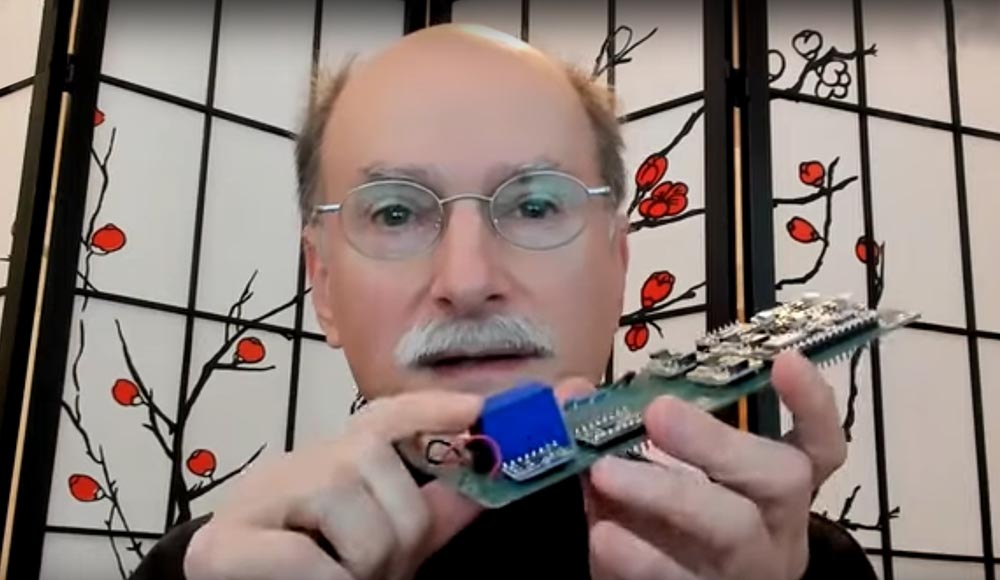

Mind and Matter Entangled
Dr Dean Radin talks about a lifetime of experimental work on the intersection of physics and consciousness
Dr Dean Radin is Chief Scientist at the Institute of Noetic Sciences [/] (IONS) and Associate Distinguished Professor at the California Institute of Integral Studies [/]. He is best known for his research on the intersection of physics and consciousness, with his work spanning over 45 years of scientific research on what are known as psi phenomena, such as telepathy, remote viewing and precognition. Using sophisticated scientific equipment and rigorous experimental design protocols, he has conducted numerous experiments designed to test the hypothesis that mind and matter are related to each other, from dice-throwing to quantum mechanics, global consciousness and the effect of intentionally ‘blessing’ chocolate. His academic output has been prodigious; he has produced nine books,[1] over 300 scientific articles, and given more than 750 talks during his career. He talked to Jane Clark and Nick Yiangou by Zoom from his home about why this work is so relevant at the present time.
 When we spoke with Dean early in 2024, he was in the process of launching a highly sophisticated new experiment entitled Scientific Investigation of Gazing with Intuition at Light (SIGIL) [/]. This focuses on the effect of concentrated intention and attention on a physical system, testing what is known as the ‘quantum observer effect’. This perplexing phenomenon has spawned intense scientific, philosophical and metaphysical debate since it was first discovered in the early 20th century, when the famous ‘double slit’ experiment showed that the behaviour of light appears to depend upon the mode of observation, appearing as a particle when the result is monitored by a particle counter and a wave when it is not. (For an engaging contemporary demonstration of this, see video right or below.)
When we spoke with Dean early in 2024, he was in the process of launching a highly sophisticated new experiment entitled Scientific Investigation of Gazing with Intuition at Light (SIGIL) [/]. This focuses on the effect of concentrated intention and attention on a physical system, testing what is known as the ‘quantum observer effect’. This perplexing phenomenon has spawned intense scientific, philosophical and metaphysical debate since it was first discovered in the early 20th century, when the famous ‘double slit’ experiment showed that the behaviour of light appears to depend upon the mode of observation, appearing as a particle when the result is monitored by a particle counter and a wave when it is not. (For an engaging contemporary demonstration of this, see video right or below.)
Video: Double Slit Experiment explained by Jim al-Khalila; duration: 9:07
But while it is now incontrovertible that the act of observation has an effect upon physical systems at a quantum level, there is less clarity about the nature of the observer. As Dean explains: “The question is: what causes the potential or possible world that is described by the mathematics of quantum theory to turn into the world of everyday experience? Many of the early pioneers of quantum theory – people like John von Neumann [/], Eugene Wigner [/] and Arthur Eddington [/] as well as later theorists like John Wheeler [/] – said it must be something non-physical because quantum theory only describes possibilities about the behavior of physical systems. So, what do we know that’s non-physical, that would not be subject to the same constraints as quantum mechanics? Consciousness is what they came up with. So the consciousness collapse interpretation of quantum mechanics is all about the idea that, as von Neumann, again, explicitly said, the thing that takes quantum potentials and turns them into classical actuals is the act of a conscious observer – a human being, or perhaps any living system – observing a quantum state.”
In our research for this interview, we have found that this is no longer the majority position within quantum mechanics. The contemporary line is that it does not matter whether the observer is a conscious human being; it can just be an instrument. Dean accepts this: “Consciousness collapse theory is just one of probably a dozen or more different current interpretations. But from recent surveys, it is nevertheless the case that approximately 20% of physicists and philosophers who are interested in the foundations of quantum mechanics say there’s something important about consciousness. This is a minority, true, but it is a large minority.” He sees his work as providing empirical data that will help to inform how to best interpret quantum mechanics.
Does this mean that the main point of his work is a philosophical one? “Absolutely. The implication that consciousness is doing something in the physical world would be revolutionary from a mainstream perspective. The prevailing philosophy in the world today is reductive materialism, which is based on a set of assumptions that do not account for subjective experience very well. And if you start from the wrong philosophy, then you end up with the opinion that things like mind–body interactions are impossible. The problem is that scientists don’t usually think about their assumptions, or they even believe that they don’t have any – that they are just dealing with facts.”
He goes on: “Those of us who are involved in spiritual traditions already assume, or at least suspect, that consciousness is fundamental in some way, but we need to demonstrate this in a way that will appeal to scientists. That’s the aim. The hope is that what we are doing will not just be of interest to the general public – who are always interested in these topics – but to the scientific world, so that we can change the taboo that prevents these ideas from even being discussed within the mainstream.”
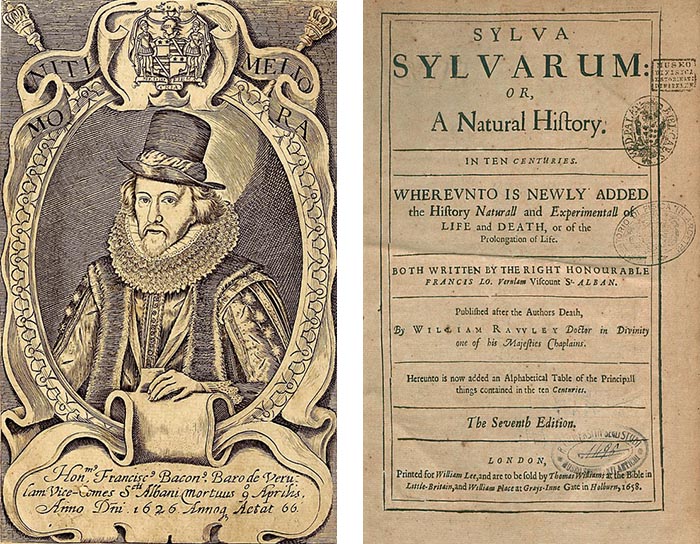
The Force of Imagination
.
It is ironic that although the idea of mind–body interaction is extremely controversial in contemporary science, it was taken for granted by the man who is widely regarded as the father of the western empirical method, Francis Bacon. Dean describes how, in Bacon’s Sylva Sylvarum: A Naturall Historie of Ten Centuries, published in London in 1627, he essentially said throughout the book: ‘If you want to know whether what I am talking about is a real thing, then test it.’ “This is the beginning of empiricism. And one of the things he mentions in the book is ‘the force of imagination’. I think these days we would understand this as meaning ‘intention’ – the force of intention. And the way Bacon suggests testing this is to toss dice. You assign one of the faces as more desirable, then you toss the dice repeatedly and see whether or not that face comes up more often than chance would dictate. And if it does, then you can conclude that the force of imagination does something.”
It was not until nearly 300 hundred years later, however, that people started to rigorously test this hypothesis. “In the 1920s, J. B. Rhine [/] at Duke University started actually doing dice experiments. He began with hand-tossed dice, then he put the dice in a cup, and then he used a machine, so the experiments gradually became more and more sophisticated over time. But they were essentially following what Bacon had suggested.” In 1991, Dean did a meta-analysis of all the dice studies which were conducted over a period of 50 years and found that there was a statistically significant difference between the behaviour of the dice when someone was willing it to fall in a certain way versus a control group where dice were tossed without being subjected to intention.[2] “But although the analysis shows that the effect is real, its magnitude was also tiny.”
By the 1970s, dice experiments were superseded by more sophisticated tests using things like random number generators, which are based on quantum indeterminate events to produce sequences of 1s and 0s in a random order. A very famous series of experiments was conducted at Princeton University’s Engineering Anomalies Research Laboratory [/] over a period of 30 years. It was found that when there was no human input, the generators produced what is called a ‘random walk’ – this is the base line (labelled BL) in the diagram below. But when people were asked to aim high (HI) (that is, produce more 1s) or low (LO) (that is, produce more 0s) there was a highly statistically significant effect.[3]
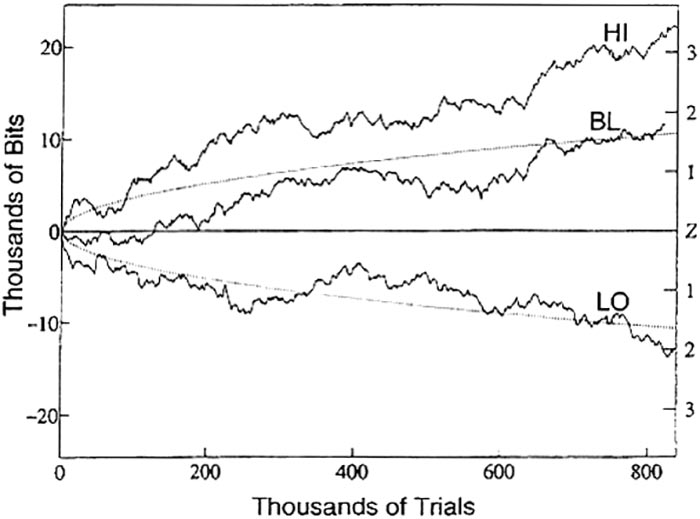
In 1989, Dean did another meta-analysis, this time on the enormous amount of data collected from about 800 similar random generator experiments conducted all over the world.[4] “The result was an unequivocal positive result when people were intentionally influencing the system, and a result consistent with chance under control conditions. But again, although it is without doubt real, it is a very small effect. This is why this work demands collecting huge amounts of data and doing very sophisticated statistical analysis on it.”

The Effect of Blessing
.
During his time at IONS Dean has himself been involved in many experiments to demonstrate and investigate mind–matter interaction. Some of the most engaging of these explore the effect of blessing upon material substances such as food, plants and cells. In 2007, for example, he published the results of an experiment with chocolate, which investigated whether blessing would enhance its mood-enhancing properties.[5]
This was set up as follows: a Tibetan monk and a Mongolian shaman were asked to mentally bless, in whatever way they wanted, some pastilles of dark chocolate. Using a double-blind placebo-controlled protocol, a cohort of volunteers was then divided into two groups, one of which ate the blessed pastilles and one of which ate exactly the same sort of chocolate which had not been blessed. Both cohorts ate their pastilles at the same fixed times every day of the week and recorded their mood at night using a validated mood reporting scale. And sure enough, the results showed that after three days, mood disturbance was significantly less – meaning that people were in a better mood – when they ate the blessed chocolate as opposed to the control. Dean comments on this: “When you do this sort of clinical trial, it is often very hard to recruit volunteers, but this was the easiest trial ever to recruit for, as we said, well, you just have to eat this special gourmet chocolate…”
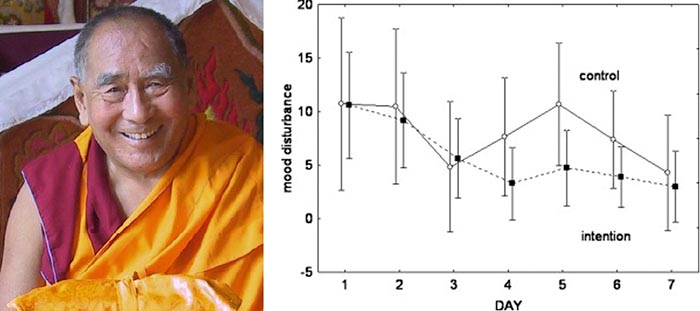
Dean has also done similar experiments using tea, exploring the effects of drinking cups of oolong [6] which had been blessed by three Buddhist monks in Taiwan. Yet again, there was a statistically significant effect, with the participants reporting better mood enhancement from the blessed tea rather than the control. More recently he has been extending this work by doing experiments which rely on objective rather than subjective measurements. For instance, in 2022 he published a study of the effects of water blessed by the same Buddhist monks on plant growth, using the well-studied species Arabidopsis thaliana. The trial showed that indeed the blessed water produced shorter, fatter hypocotyls – a sign of sturdy early development – than the control group.[7] “The physical effect in this experiment is quite small”, Dean comments, “but statistically there was no doubt about the effect.”
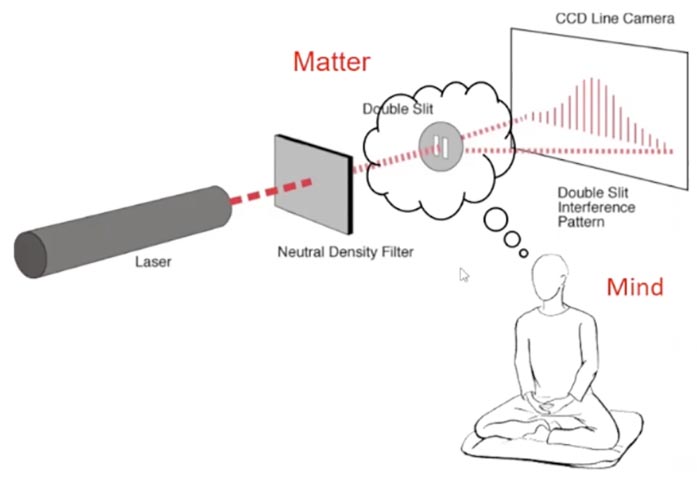
More on Double-slit Experiments
.
There is also the series of experiments using the quantum observer effect which IONS has been conducting over the last twenty years, culminating with the SIGIL study. The experimental set-up for these is shown above. Basically, they are double slit experiments which generate an interference pattern on the screen. A human observer is then asked to attempt to either observe the photons as they go through the slits, or to influence them to go through one rather than the other. This is of course done not with their eyes but in their imagination – their mind’s eye – as the apparatus itself is just a black box (for a detailed explanation of these experiments, see video right or below). The prediction is that observation will have the effect of reducing the amplitude of the interference pattern.
Video: Dean Radin speaking at the 2016 Tuscon Conference on the Science of Consciousness; duration: 41:04
And this is precisely what is seen, as shown by the results of a pilot trial below. One of the interesting things here is that the deviation from chance is dependent to some degree upon the participant. People who practice meditation produce a much larger result. This is not, Dean explains, necessarily because of some special talent that meditators have – although it seems that there might also be an issue of natural talent – but simply that they are trained in the central task required, which is attention and concentration.
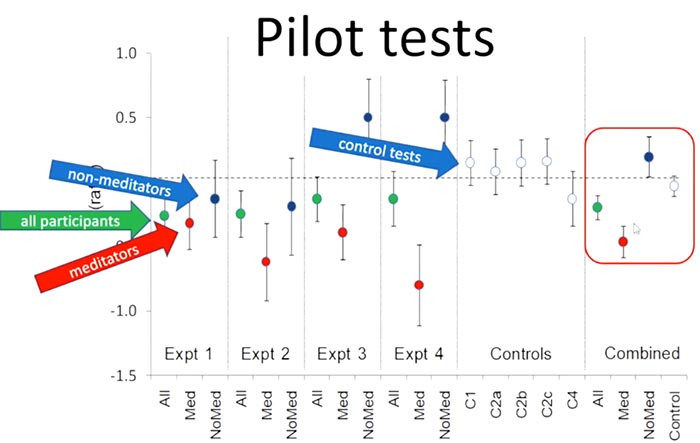
Results of the double-slit experiments, showing that attention/intention had a statistically significant effect on reducing the height of the interference pattern. Meditators (red dots) had a stronger effect than non-meditators (blue dots). Image: Courtesy of Dean Radin
As time goes on, more and more rigour has been introduced to the methodology of these experiments so that alternative explanations are excluded. For instance, the possibility that the body heat of a physical person close to the system was changing the conditions was eliminated by conducting the experiment online. For SIGIL, he is also doing something he has not tried before – recruiting, specifically, long-term meditators and people who do esoteric practices and martial arts. “We were looking for participants who have a strong practice and interest in both focused attention and intention. We ask people to alternately concentrate for 30 seconds, then take a break for 30 seconds, in sessions lasting up to 20 minutes.”
We ask whether it matters what kind of concentration or intention people bring to the task. “Actually, it’s not clear whether it’s just the presence of a conscious observer that produces results, or whether it’s the intensity of conscious intention. Because, from a conventional physics perspective, all that is necessary is to gain information about which path the photon takes. Just by gaining which-path information, one will collapse the wave function and modify the result. So, in this test, I tell people that they can also use psychokinesis – meaning, they can try to mentally push the laser beam so it moves a little bit – or whatever they want. They are free to try all kinds of different things. I don’t think it matters whether the participants are just gaining information or pushing it. It’s an informational process either way, and it is this that causes the photon to behave differently as compared to if it wasn’t being observed at all.”
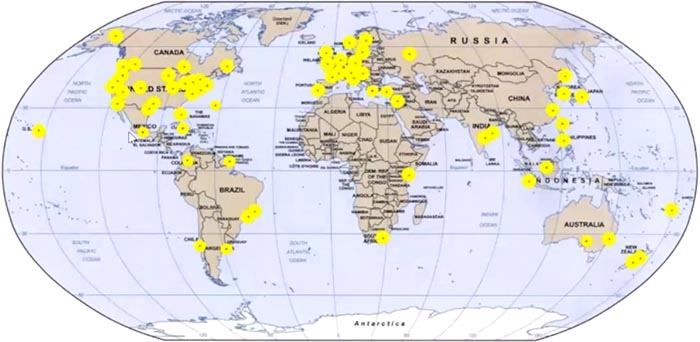
The Global Consciousness Project 1. The yellow dots indicate the placement of participant ‘citizen scientists’ with random number generators. Image: Courtesy Dean Radin
Global Consciousness
.
Another important part of Dean’s work over the past thirty years has been the Global Consciousness Project (GCP) which is designed to investigate the effect of shared human experience on global consciousness. The first version of the project, GCP 1, was started by Roger Nelson at the PEAR Lab at Princeton in 1998 and is now hosted by IONS. It ran as a formal experiment until 2015 but is still running informally and producing data. We asked Dean about the idea behind the project: “Well, the metaphor that I use is of a tsunami detector. If you wanted to know if there’s a tsunami coming in the ocean, you would drop a number of buoys at different locations and then measure various things – let’s say something simple like the height of the buoy. If you’re monitoring that information continuously, and you suddenly see that a significant number of buoys are floating up at the same time even though they’re thousands of miles apart, you can infer that there’s a gigantic wave – a tsunami – coming.
“GCP does the same thing, except in this case the hypothesis is that there is the equivalent of an ocean of consciousness. We live inside this ocean all the time, but just as fish are not aware of water, we don’t ordinarily see it. But we’re in it, and everyone’s thought is part of it. Most of the time the effect of collective consciousness is totally random; just like waves on top of the ocean, they’re not correlated with each other. But occasionally, during the opening ceremony of the Olympics or some other big world event, there are millions or billions of people paying attention to the same thing at the same time. That creates a correlation among these tiny little waves. And the hypothesis behind GCP is that this correlation may be reflected in the physical world.”
In GCP 1, the equivalent of measuring the height of the buoys was performed by monitoring the behaviour of random number generators, which, as Dean has already explained, are designed to produce a random distribution of 1s and 0s. “We provided people – ‘citizen scientists’ – in major cities all over the world with random number generators and monitored their output continuously, once per second. This allowed us to automatically have data when large-scale global events were unfolding – things like the 9/11 attacks on the twin towers in New York, the funeral of Nelson Mandela or the opening of the Olympic Games. In this way, it was possible to see if the random number generator network was not behaving quite so randomly anymore. By putting these generators around the world – and there were about 50 of them on average, reaching 70 at certain times – we created what amounts to a kind of a net that surrounded the world inside this hypothetical ocean of consciousness. When a billion people were watching something on live TV at the same time, we predicted that all the random generators would start to show some degree of order and coherence.”
And what was the result? “Well, the prototypical event was 9/11. A lot of people were watching live news programmes discussing the attack for days after it happened, and almost anybody who was able to was watching the television in a kind of state of shock and awe. At that time, there were something like 21 random generators going, and a deep analysis of the data made it very clear that randomness went away. All kinds of things just went haywire.”
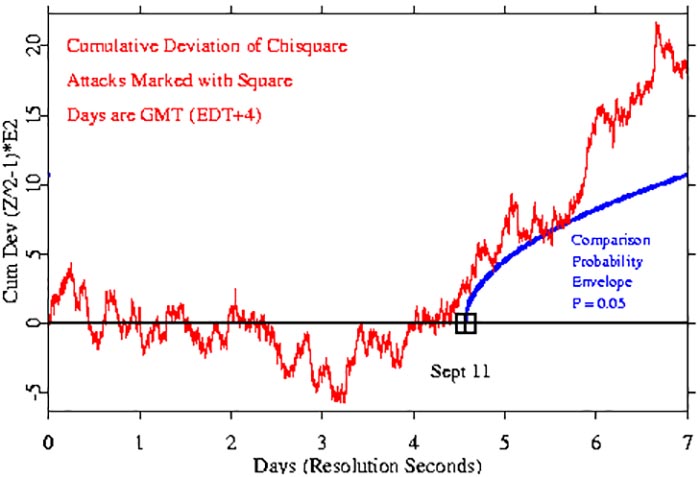
The goal of the overall GCP experiment was to record 500 large-scale world events. “After that was achieved in 2015, we analysed the results and found that the overall odds of the results deviating from chance during these events was about three trillion to one. In statistical terms, it was a 7.3 sigma effect.” We comment that this seems like an enormously impressive result. Dean agrees: “Two sigma is normally considered enough to establish that a phenomenon is interesting, and within physics a five sigma result indicates that it is a ‘discovery’. So there really is no possibility of this being a chance outcome.”
A second version of the experiment, GCP 2, has just been launched this year. Dean explains that this is planned to have not 70 but 1,000 generators around the world, and they are of a different and improved design. “They are basically quantum noise generators, and the idea behind using them is that we are hoping that some light will be shed on what is happening at a quantum level. The new project also has an automatic ongoing measure of world sentiment, perhaps even split down into countries, so that experimenters don’t have to decide when they’re going to look at something.” GCP 2 is an open project which everyone can access, and it is already generating live data that can be found on their website [/].
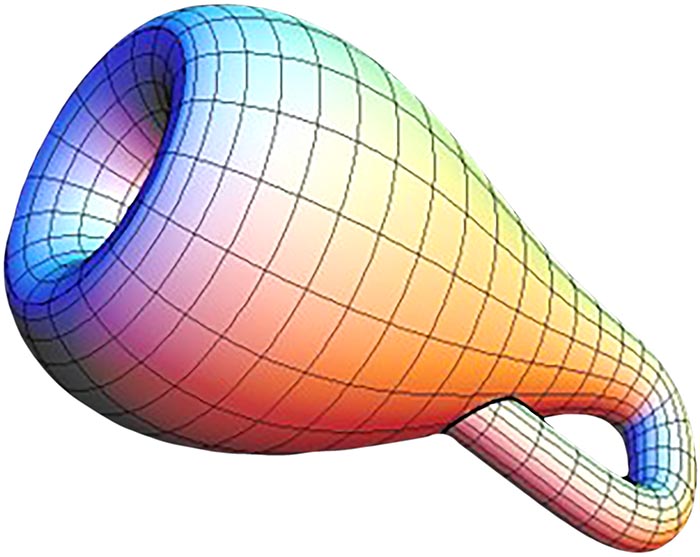
The Klein Bottle. This extraordinary mathematical construct looks as if it has an interior and an exterior but it is actually a one-sided surface. Image: via Wikimedia Commons
Explaining Mind–Matter Interaction
.
Dean accepts that these experiments will probably not change people’s behaviour very much, as those who accept that our intentions have an effect upon the world are already practicing things like prayer, dedication and blessing when they are cooking, or when undertaking healing, etc. He thinks that the main import of his work is the way it will eventually change our worldview. “What happens in the world and the way we interact with it follows along from our worldview. So acknowledging that consciousness is fundamental in some way – that it’s part of the fabric of reality and not reducible to brain activity – will eventually change many, many things. For instance, there are obvious implications for things like survival after bodily death. If part of us is not physical and is not part of our brain, then our consciousness may not die – at least in the way that we think of the body as dying. Something may persist.
“Or it may be that things which don’t have a human body can be conscious. Maybe a tree is conscious. Or maybe there are giant bags of gas out there in space that are conscious in some way, as people who advocate panpsychism believe. This line of research is beginning to add fuel to many ideas that only philosophers used to talk about but are now penetrating into the scientific world.”
We asked him about his own thoughts on the various meta-narratives that are arising now as we attempt to move the needle from physicalism and materialism to more inclusive models. He tells us that the most compelling model for him is dual-aspect monism [/] as it has been expounded in a recent book by Harald Atmanspracher and Dean Rickles.[8] This is the view that the mental and physical realms are two aspects of, or perspectives on, the same substance. “I used to think that maybe full-blown idealism was the way to think about these things, and maybe that’s still true. But I find it difficult to figure out how one starts with something that is completely non-physical and then it becomes physical.”
By idealism, we assume, he means the view that consciousness is the prime substance and that matter derives from it – a model that is proposed in the present day most famously, perhaps, by people like Bernardo Kastrup and Federico Faggin (see the article in Beshara Magazine). “Yes. But in dual-aspect monism, the mental and the physical are understood as two ways of seeing one underlying undivided reality that is psychophysically neutral. This idea was expressed decades ago by Carl Jung, who famously said about what he called the unus mundus: ‘Mind and matter are two aspects of one and the same thing’, but it has also been articulated by many physicists such as Arthur Eddington, John Wheeler and David Bohm.”
He goes on to explain that a good visual aid to understanding the theory is the Klein bottle [/]. This was created by the mathematician Felix Klein in 1882, and like the moebius strip, is basically a one-sided surface which, if travelled upon, could be followed back to the point of origin while flipping the traveler upside down. “The Klein Bottle looks like it has an inside and outside, but it’s actually one surface, so the interior and exterior cannot be ultimately separated. The important insight of dual-aspect monism is that the split between mind and matter depends upon context and meaning. This allows us to understand how matter can have its own existence – its own life and behaviour and whatever – but at the same time be correlated – tightly correlated, entangled – with consciousness space. This correlation allows consciousness to do things with the physical world and vice versa, so suddenly we have a plausible way of thinking about all the anomalies and mysteries and psychic things I have been studying.”
Another advantage of the theory is that it does not do violence to what we already know – in physics, especially, but also throughout all of academia. “It wouldn’t change anything in the textbooks. All we would need is a footnote somewhere saying that all this is a special case of a larger, more comprehensive way of thinking about things where consciousness also plays a role, even if we don’t yet quite understand exactly how.”
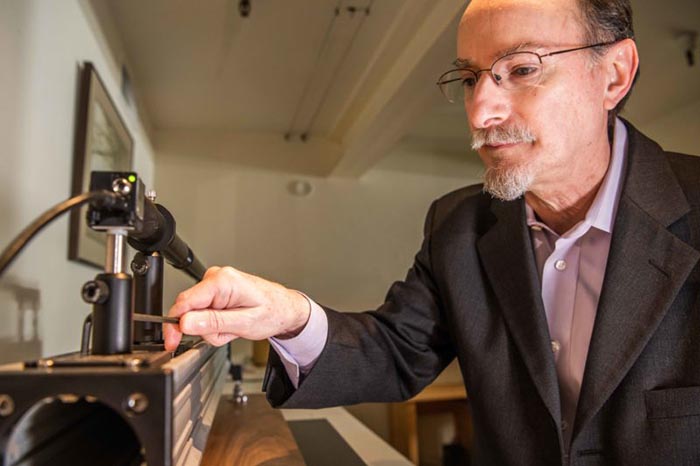
Legacy
.
In closing, we asked Dean if there was anything he wanted to add, and he spoke about what his legacy might be after a lifetime of research into mind–matter interaction. “Someone asked me about this recently, and it gave me pause for thought. A lot of my work requires a level of diligence and detail which is not always exactly pleasant, because in the scientific process, one is constantly questioning oneself and expecting to be questioned. Everything has to be nailed down absolutely tight. This is very useful because it gives you higher confidence in any results that you get but it’s not always fun to maintain that level of obsessiveness.”
But about a year ago, he was contacted by a producer of TV shows in Hollywood who wanted to put together a TV series, probably for a streaming service, with the plot line of a secret government programme doing investigative work using psychics. The idea was based on the Stargate Project [/], which in the 1970s and 80s was a US government programme investigating the potential for psychic phenomena in military and intelligence applications. “This producer knew that I had worked on Stargate and had read some of my work. So he asked whether I would be interested in being a consultant on this TV series, reviewing the scripts and making them as realistic as possible, but still creating a story that would be entertaining.
“So I thought, well, I could write scientific papers until I’m blue in the face, but the number of people who will read them as compared to the number of people who watch a TV show – well, there’s no comparison. Millions in one case and a few thousand in the other. So I worked as a consultant on the pilot script for this series and who knows? A movie or TV show in today’s world has the potential to reach many, many more people than even books can. The four popular books I’ve written have sold about 200,000 copies, so they’re also out there, hopefully sparking some interest, and helping to bring about the change in our worldview that I think is so desperately needed.”
Image Sources (click to open)
Banner: Dean Radin demonstrating the hardware for the SIGIL experiment. Image: SIGIL website [/].
Inset: The SIGIL logo.
Other Sources (click to open)
[1] DEAN RADIN: Entangled Minds (Parview, 2006), The Conscious Universe (HarperOne, 2006), Real Magic: Ancient Wisdom, Science and the Secret, Powers of the Universe (Harvey Books, 2018).
[2] DEAN I. RADIN AND DIANE FERRARI, Journal of Scientific Exploration, 1991, Volume 5. Number 1, pp. 61–83.
[3] R.G. JAHN, B.J. DUNNE, R.D. NELSON, Y.H. DOBYNS, G.J. BRADISH, ‘Correlation of Random Binary Sequences with Pre-stated Operator Intention: a Review of a 12-year Programme’ in Explore, 2007, Volume 3. Issue 3, pp. 244–253.
[4] DEAN I. RADIN and ROGER D. NELSON, ‘Evidence for Consciousness-Related Anomalies in Random Physical Systems’ in Foundations of Physics, 1989, 19, ? 1499–1514.
[5] RADIN et al, ‘Effects of Intentionally Enhanced Chocolate on Mood’ in Explore, 2007, Volume 3, Issue 5, pp. 485–492.
[6] Y.J. SHIAH and D.I. RADIN, ‘The Metaphysics of the Tea Ceremony: A Randomized Trial Investigating the Roles of Intention and Belief on Mood Whilst Drinking Tea’ in Explore, 2013, Volume 9, Issue 6, pp. 355–360.
[7] YUNG JONG SHIAH, HSU LIANG HSIEH, HUAI JU CHEN and DEAN I. RADIN, ‘Effects of Intentionally Treated Water and Seeds on the Growth of Arabidopsis thaliana’ in Explore, 2021, Volume 17, Issue 1, pp. 55–59.
[8] HARALD ATMANSPRACHER and DEAN RICKLES, Dual Aspect Monism and the Deep Structure of Meaning (Routledge, 2024).
FOLLOW AND LIKE US
——————————————
——————————————
——————————————
Video: Double Slit Experiment explained by Jim al-Khalila; duration: 9:07
Video: Dean Radin speaking at the 2016 Tuscon Conference on the Science of Consciousness; duration: 41:04
FOLLOW AND LIKE US
If you enjoyed reading this article
Please leave a comment below.
Please also consider making a donation to support the work of Beshara Magazine. The magazine relies entirely on voluntary support. Donations received through this website go towards editorial expenses, eg. image rights, travel expenses, and website maintenance and development costs.
READ MORE IN BESHARA MAGAZINE
Connecting with the Unseen World
Kira Perov, wife and long-term collaborator of the video artist Bill Viola, talks to Jane Carroll about the ideas and experiences which inspire their work
Wholeness, Timelessness and Unfolding Meaning
An interview from the archives with physicist and philosopher David Bohm
Mind over Matter
Scientist and philosopher Bernardo Kastrup discusses his critique of the materialist paradigm and argues that reality is essentially mental
The Matter with Things
Dr Iain McGilchrist discusses his most recent book which brings together neuroscience, psychology and philosophy into a unified vision
READERS’ COMMENTS
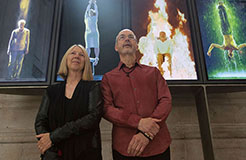
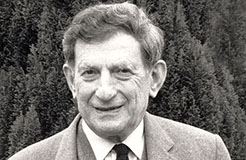


In the article by J.M Burgers, Causality and Anticipation, he states that in the philosophy of Alfred North Whitehead, it is permissible to hypothesize that thought may affect the probabilities of the quantum mechanical level.